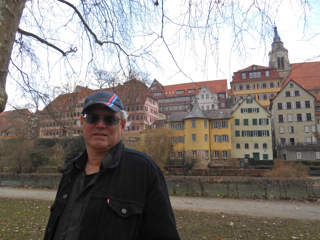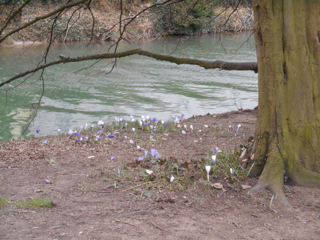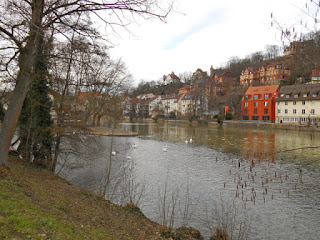by
John Kinsella
I drag and drop my terms from a previous
investigation of presence into this ‘new’ one, or into this present one. The
multiplicities of polysituatedness, the echoes, murmurs and stains of
temporariness. Here for a relatively short time, but not briefly, as I have
been before, I am present ‘in company’. My company is more than my own, and as
I age, I age with someone else. Tracy and I share much of origins in common.
Ancestry, locality, the same television programmes as children, and decades
together. We etch-o-sketch each other’s spatial and temporal presences. We
overlap. And here, in Tübingen, we overlap in our temporariness. Both of us
record our presence and observations of the town and environs in our own way —
directly, indirectly — but we are also observed by others alone and together.
We do not know what these observations, maybe recordings, mean, but they are
there. We are background to the State’s (attempted, at least) observations of
all who pass through, and we are in dozens of photographs taken by visitors and
residents. The old town is a town that is photographed. The machine is used to
capture, but each face or back-of-the-head caught by the machine escapes the
function of the machine. Mostly, photographers won’t notice the detail till
later. And even then, they might well look around the ‘distractions’, the incidentals
in the photos, to see what they want to see. One might be photoshopped out of
existence, out of the time marked at the bottom of the image. I have Walter Benjamin’s The Arcade Project on my
lap, opened to the section on photography. I am recollecting and tracing
because I want to show a poem is not a photograph. Not for me. Is it really for
any poet? It might be referred to as such by a critic, as an insult, or maybe
as an act of détournement by the poet, or as a commentary on how a photo sees
and is seen as opposed to a poem. A sequence of poems: Photographs on... or
Snapshots of... Already the title ironises or at least ‘sets up’ the way we
frame the poems that follow. All that is seen in the moment. But then, the
still photograph in the next frame. Or run together through a slideshow, a
different kind of movement, a disrupting film. Benjamin: ‘Symptom, it would
seem, of a profound displacement: painting must submit to being measured by the
standard of photography: ‘We will be in agreement with public in admiring...
the fine artist who... has appeared this year with a painting capable of
holding its own, in point of delicacy, with daguerrian prints.’ This assessment
of Meissonnier from Auguste Galimard's Examen
du Salon de 1849 (Paris, 1850, p. 95, cited in Benjamin, p. 685). This is followed by ‘Photography in
verse’ — synonym for description in verse. Edouard Fournier, Chroniques et légendes des rues de Paris
(Paris, 1864, pp. 14-15, in Benjamin, p. 685). And, of course, one must reference the referencing of this by saying The Arcades Project by Walter Benjamin
(trans. Howard Eiland and Kevin McLaughlin, prepared on the basis of the German
volume edited by Rolf Tiedemann; Harvard University Press, Cambridge and London,
1999, p. 685). Whose reference system is this? I track my journey and you can
follow, too. Scrutiny, gate-keeping, appropriate behaviour. See me as others
might see me. See us as others would see us. But let’s go back a few pages,
altering the sequence (dipping in?), and read: ‘One of the — often unspoken —
objections to photography: that it is impossible for the human countenance to
be apprehended by a machine. This the sentiment of Delacroix in particular’
(op. cit. p. 678). Why do I go here? Well, the strands of belonging and
unbelonging take me to the photo Tracy is taking — I am there again, NOW — of
me on the Neckar Island outside, across the river from the Hölderlin tower. Not outside, really, but
almost opposite. At a slight angle, to avoid getting others in the shot — dogs
and their walkers, people discussing their problems. We are in the alleyway of plane trees,
the same trees Hölderlin would have looked onto out across the
river, in their youth. The island. I feel most connected to both my aloneness
and my sharing of life-space on islands. It was absence of family on Cocos;
with family on La Réunion; with family again here, on this small river-island.
The ancient trees have been tagged with graffiti. Between the old town keeping
an eye on, and the new town eyeing off? Both, really. Crocuses are out. There
are no four seasons anymore, not even here, and the prompts to emergence are
conflicted.
Tracy takes all the photos of our presences beyond Jam Tree Gully. She carries the camera. She embraced digital photography very early on not in praise of technology — she shares my doubts, objections and often refusals — but because this way she could get around the issue of animal products in the manufacture of film and developing of photographs. I think of this as she snaps my photo. As a child, I did all I could to avoid being photographed. There are quite a few childhood photographs of me, but fewer than there would have been. Seeing myself disturbed me as much as hearing myself on cassettes. Early cassette-players. All these devices to show we’ve been, to carry our timbres to others, to say we have trodden here as well, maybe (slightly) before. The markers of presence. The painting marks the presence of the painter more than the subject. Does the photo mark the presence of the photographer in the same way? Our temporariness here has stretched to breaking-point; we risk becoming familiar. That familiarity of the outsider who stays and stays and sees what is uncomfortable even when not looking. It’s easy to see the overt badness: the hatred of refugees by some, the violent moments on a back street, the racist graffiti, the brutal presence of the past under the utopias of early modern architecture. It’s also easy to see the good (I don’t use scare quotes): people living as people, welcoming refugees, the anti-racism, and a strong environmental consciousness. As I would arrange good and bad. As I would picture the qualities of each. But the liminal comes into focus over time, and one realises the Green emphasis is also mixed with capitalism, that the head of the Greens in the state is proud of his Mercedes and wants the state to be used as a dumping-ground for radioactive waste. The blurring. The state party system adapts to the emphasis of place, and beneath all the good and bad is a commercial drive, a desire for goods. Telephones, cameras, computers. They might be used to undermine the capitalist enterprise, but they reinforce it more than they undermine. The violent ones, those from the circles of Dante’s Inferno, worship goods to remake the world in the image they ascribe to some other force but which is really a reflection of self-desire and often self-hatred. I think this while being photographed opposite (almost) ‘Hölderlin’s tower’ (it wasn’t his tower, it was the carpenter Zimmer’s and his family’s) and thinking of the industry that has grown around his supposed madness, his fall, his ‘lesser’ late poems which I think burst out of their formulaics to be masterpieces of subterfuge, mocking the very fame he had obsessed over when young. He was not insane. His tower glows. An edifice. Graffiti approaches along the walkway. It will be tagged.
 |
| JK photographed by Tracy Ryan; Hölderlin tower behind |
Tracy takes all the photos of our presences beyond Jam Tree Gully. She carries the camera. She embraced digital photography very early on not in praise of technology — she shares my doubts, objections and often refusals — but because this way she could get around the issue of animal products in the manufacture of film and developing of photographs. I think of this as she snaps my photo. As a child, I did all I could to avoid being photographed. There are quite a few childhood photographs of me, but fewer than there would have been. Seeing myself disturbed me as much as hearing myself on cassettes. Early cassette-players. All these devices to show we’ve been, to carry our timbres to others, to say we have trodden here as well, maybe (slightly) before. The markers of presence. The painting marks the presence of the painter more than the subject. Does the photo mark the presence of the photographer in the same way? Our temporariness here has stretched to breaking-point; we risk becoming familiar. That familiarity of the outsider who stays and stays and sees what is uncomfortable even when not looking. It’s easy to see the overt badness: the hatred of refugees by some, the violent moments on a back street, the racist graffiti, the brutal presence of the past under the utopias of early modern architecture. It’s also easy to see the good (I don’t use scare quotes): people living as people, welcoming refugees, the anti-racism, and a strong environmental consciousness. As I would arrange good and bad. As I would picture the qualities of each. But the liminal comes into focus over time, and one realises the Green emphasis is also mixed with capitalism, that the head of the Greens in the state is proud of his Mercedes and wants the state to be used as a dumping-ground for radioactive waste. The blurring. The state party system adapts to the emphasis of place, and beneath all the good and bad is a commercial drive, a desire for goods. Telephones, cameras, computers. They might be used to undermine the capitalist enterprise, but they reinforce it more than they undermine. The violent ones, those from the circles of Dante’s Inferno, worship goods to remake the world in the image they ascribe to some other force but which is really a reflection of self-desire and often self-hatred. I think this while being photographed opposite (almost) ‘Hölderlin’s tower’ (it wasn’t his tower, it was the carpenter Zimmer’s and his family’s) and thinking of the industry that has grown around his supposed madness, his fall, his ‘lesser’ late poems which I think burst out of their formulaics to be masterpieces of subterfuge, mocking the very fame he had obsessed over when young. He was not insane. His tower glows. An edifice. Graffiti approaches along the walkway. It will be tagged.
This
end to Benjamin’s Photography section does something for me and maybe this text
as well: ‘Cocteau’s Les Mariés de la tour Eiffel can perhaps be considered a “critique of the snapshot”, insofar as
in this piece the two aspects of shock — its technological function in the
mechanism and its sterilizing function in the experience — both come into
play.’ (Benjamin, p. 692) This notation to brutality (the consequences of a Sunday stroll?), to Cocteau’s critique of the
bourgeoisie reinvented in the gallery of the book, or the accumulation of notes
towards the book, does not accord with the moment of being photographed in
front of Hölderlin’s tower. (There was no violence; however, behind the façade of any pleasant moment within the State is the knowledge that the pleasantness comes at a cost to the world somewhere else.) But it does accord with the ecology of presence around it,
and of which we make ourselves part.
There is no beauty in ‘history’. The dialectic rejects it. I do not
‘watch the birdie’ when Tracy ‘snaps’ me. I am there, and she is in front of
me, and I look at her obscured by the machine. But I see past the machine to
Tracy. I know she is there, and that she will look at the picture later. I know
it is part of a narrative she is making where a narrative is, but is also
diffused and lost. That narrative isn’t fixed, and its purpose will change over
time. I am happy to be part of it: a recording, of course, but also an act of
temporariness against the hauntings of temporariness. Not to say we have been,
but to say we are. Not to own presence, but acknowledge it. Tracy’s brother
Sean, who died when he was eighteen, was a photographer and was going to study
to be a ‘professional photographer’. I am told that as a child he liked the
tricks of the camera, all it could do in terms of changing our perceptions of
what actually was and is. The person standing on the palm of a hand, the warping of
perspective. But there is no change to reality, just a play on the way we see.
He was interested in temporariness, he died young, but marked his places in so
many ways. Not damaging, but imprinting over so many other previous imprints,
and in the imprint of presence continuous. In Tracy’s ‘snaps’ are her brother’s
imprints. In a world where negatives are a fading memory, his negative develops
the island without damaging the trees, a negative made positive in a place so
far from where he lived and died. The ‘other side of the world’ (a place he
never left), but here all the awareness of the indelible nature of ‘history’
and its images would have pressed on him also.


